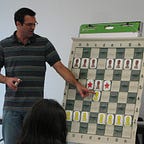I have an old friend I used to play quite a bit of chess with who was able to use his chess skills in a variety of ways away from the board, which really is the ultimate use of chess skill.
Since I teach my students to use their chess skills in real life situations all the time, I figured I would relate this story of my friend today. Maybe someone reading will connect these topics for the first time as a result.
My friend used to solve a problem or confront a challenge in his life by, as he put it, “Chessing it out.” He’d usually use the made-up verb in past tense when recounting his triumph by telling me, “I chessed that stuff out, man!”
What did he mean?
Well, in chess, one of the key skills for any player is calculation, which I’ve written about before. The simplest way to describe calculation is: figuring out what’s going to happen next.
When you make moves in chess, you calculate what the other player might do in response and then what you plan to do next as a result. On and on you go, ‘looking ahead’ as far as you can do so before playing your move.
At least, that’s what you should be doing when you play!
As I wrote about in another post, if kids are not taught how to do this and an instructor instead takes for granted that they will just instinctively know how to do it, those kids are being short-changed and should find a new instructor!
The art of figuring out what’s going to happen next is key to discovering the consequences of your move. This is where life and chess meet in the middle.
The game of chess is all about discovering the potential consequences of your actions and then evaluating which consequences are better for you than others. Theoretically, you choose the move that results in the best consequences for you and that work in your favor.
Sounds a lot like life, doesn’t it?
In this chess position above, from one of my own games, I was considering the effects of playing …Rxf1+
This kind of move is called a forcing move in chess because it forces the opponent to respond. The rules of chess say that when you’re in check, you must use your move to escape. So my opponent would have only two move choices: Kxf1, recapturing my rook, or Kg2, running away from the attack.
Naturally, the only choice that makes any sense is to capture my rook. Running away would simply allow my rook to capture his for free.
So what do I plan to do next? Well, with his king now on f1, I can capture the bishop on e3 and check again (Nxe3+). Another forcing move, which encourages his pawn on f2 to capture my knight. In much the same way, moving his king would just allow me to grab his bishop for free.
So I’ve been able to figure out each of our next two moves because his responses are forced. When I visualize the resulting position, I need to evaluate it and figure out if I like it or not. Here is what I saw:
This position works in my favor because I have more pawns than my opponent and I know through experience how to get one of them to the end of the board and make a new queen, while preventing my opponent from doing the same.
Once I got to this point, I knew to play Rxf1+, which I did. The following moves played out exactly as I had expected, and I went on to win the game.
So that’s calculation in chess… What does it have to do with life?
Well, as my buddy would say, the more accurately you can figure out what’s going to happen as a result of your actions, the easier it becomes to make a decision and/or to solve a problem or a challenge you’re facing.
So “chessing it out” means looking at your available options and projecting into the future to see what effects each option will have on the overall big picture of the problem you’re trying to solve.
Then you select the option that you believe will bring you the best result. Just like a chess player would.
Going for a promotion at work? What are the different ways you can go about improving your standing and making yourself the ideal candidate? There are bound to be several. Figure out which option will give you the best return on your time and effort and go for it!
And the great thing about a promotion at work, as opposed to chess, is that you don’t have to pick just one option and leave all the others out. You can look ahead on each of them and pick two or three that all seem beneficial, then prioritize based on how much you feel each one will help you.
You can do all of them and really strengthen your standing. In chess you can only pick one.
So I encourage you, even if you don’t play chess, to “chess out” your major decisions. Sit down and figure out what course of action will lead to the best result and consider many different options — like a chess player would.
It may be difficult at first, just as calculation is difficult for a new chess player to master. But the more you do it the better you get.
I think you’ll be encouraged by your results.
Drop me a line at: coachrob@kidsnchess.com with your thoughts. I’d love to hear from you!
